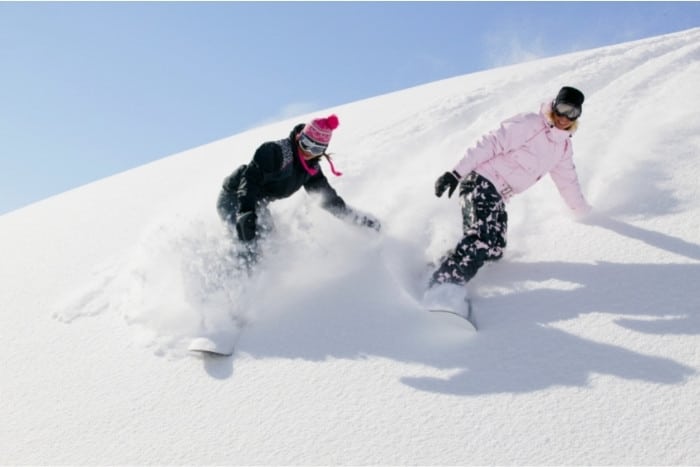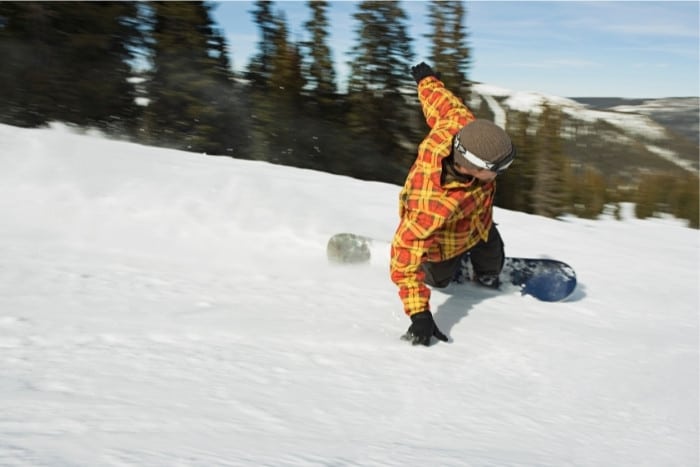If you’re in the market for a new snowboard, you might wonder what the pros and cons of opting for a shorter board might be. Different board lengths offer a range of benefits and drawbacks depending on your riding style and the snow conditions. So you may find that knocking a few centimeters off your recommended snowboard size improves your technique and makes your time on the mountain more enjoyable.
In general, a shorter snowboard can be a better option for beginners as they make turning easier and can be more forgiving when snow cover is poor. However, depending on your board’s profile, the smaller surface area might be a bad choice if you’re heading into the backcountry.
To help you decide if a shorter snowboard is the right way to go, we’ll cover a few of the pros and cons of picking a smaller model.
Pros Of A Shorter Snowboard
First, let’s take a look at why opting for a shorter snowboard may result in a better riding experience.
1. More Maneuverable
The way a snowboard’s edges curve is known as the sidecut and is why your board can turn in the snow. We can describe the size of a board’s sidecut using a measurement called the side cut radius.
If you were to imagine the curved edge extended all the way around to form a complete circle, the radius would be the distance from the circle’s edge to the center.
We can use this figure to determine how easily a snowboard will turn; a smaller radius indicates a deeper sidecut and a board that will turn more sharply, whereas a larger radius and shallower sidecut will result in smoother turns that take longer to execute.
Generally speaking, a shorter snowboard will have a shorter, deeper sidecut and be much easier to turn on, making them an excellent option for beginners.
They’re also great for rides where high maneuverability is necessary like dense tree runs.

2. Better In Poor Snow Conditions
While every snowboarder dreams of blue skies and inches of fresh, powdery snow, the reality is almost always a little different.
Sometimes you have to make do with the conditions you have, which might be hard-packed, groomed slopes, and even patches of ice.
If this is the case, you might have a better time riding if you opt for a shorter board than usual.
A shorter board is going to have shorter edges, meaning it’ll be easier for you to engage more of the effective edge with the piste while carving, turning, or stopping.
Overall, this means you’ll reduce the likelihood of your board failing to cut into the thin layer of snow or ice and minimize the risk of bailing and hurting yourself.
With a smaller snowboard surface area, you’ll also accelerate less quickly than you would on a longer board which can be a real benefit when snow conditions are difficult to predict.
3. Easier Freestyle Riding
If you spend more time in the park than carving down the mountain, a shorter board is the way to go.
As mentioned above, executing sharper turns will make it easier to pull off spin tricks, and a smaller, lighter board will make it easier to get big air off kickers and perform aerial stunts.
A shorter, wider board also makes riding boxes and rails more forgiving, both in terms of getting into position and maintaining balance, and the smaller size is better for practicing those buttery ground tricks.
You might also find it easier to get the most out of a board’s flex if you have a higher weight-to-board ratio.
The exception here is if you’re going to be riding the halfpipe frequently, as a longer, stiffer board will make it easier to engage your edges with the curved sides of the pipe and get the height necessary to pull off big air tricks.
Cons Of A Shorter Snowboard
Now, let’s examine the drawbacks of a shorter snowboard and how it can affect your ride.
1. Less Stable At High Speeds
While a shorter snowboard allows for more aggressive turning, a longer board is much better for smooth, drawn-out carving at high speeds.
A longer board is also likely to be heavier; the increased mass means greater acceleration and a higher max speed.
On a shorter board, you’ll start to feel it “chatter” as you move more quickly, and you’re more likely to skid out as you struggle to hold an edge.
When it comes to snowboarding, everyone’s definition of “fast” differs, but if you lack enough control or stability, you may want to choose a bigger board.
Having said that, some modern snowboards now feature serrated edges, like Lib Tech’s Magne-Traction technology, that increase the number of contact points with the snow and make it much easier to hold an edge at speed.
These features may bump up the price of a snowboard but make for a great all-mountain option that lets you zip down the hill with a piece of equipment that can also handle itself in the park.

2. Toe and Heel Drag
Generally speaking, a shorter snowboard will also be narrower than a longer one.
This is because most manufacturers base their size guides off body weight and assume that a heavier rider will be taller and wear a larger boot size.
Your snowboard boots should slightly overhang the edges of your board to allow you to use the minimum amount of energy to engage the edges.
If your boots are too big for your snowboard and stick out too far when you turn, you’re likely to catch your heels or toes in the snow, which will either kill your speed or result in a wipeout.
Fortunately, manufacturers are aware that snowboarders with bigger feet might not want to be stuck with a longer board that doesn’t fit their riding style.
Now, many models come in both regular and wide varieties. The waist width of a “wide” board is usually around 160mm or higher and is the recommended option for riders with a US size 12 boot size or larger.
3. Sinking In Powder
If you’re lucky enough to wake up to a dump of fresh powder or have access to stellar backcountry riding, you may want to leave the shorter snowboard at home.
For deep snow, a longer, wider board has a much greater surface area that provides better flotation and means you’re less likely to sink and get stuck.
To ride in deep powder, you’ll want to keep your weight positioned over the tail of the board, and a longer board allows you to position your bindings further back to make this a less demanding task.
A shorter board won’t give you much wiggle room here, and it won’t be long before your back calf starts cramping up and potentially ruining your ride.
If you are going to hit the deep stuff on a shorter board, try and pick a snowboard with a rocker profile, as the upturned nose will force the snow under your board and make it much easier to stay on top of the powder without getting stuck.
Final Thoughts
Ultimately, there are plenty of great reasons to choose a shorter snowboard than the size charts suggest, especially if you’re a beginner or want to spend time perfecting your tricks in the park.
If you plan on venturing out in the backcountry or trying to hit high speeds on the slopes, a longer snowboard is likely the better choice, but the best way to be sure is to try out a few different boards and see what feels most comfortable.
